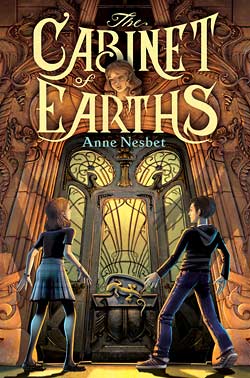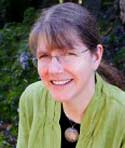Film and Slavic-language scholar now a kids’ book author, too
Slavic languages scholar Anne Nesbet has long been moved, as a reader, and intrigued, as a teacher and academic, by children's literature. Now her "a-shimmer with magic" debut novel, The Cabinet of Earths, is on the kids' book shelves.
April 18, 2012
Living in a rented apartment near the Eiffel Tower during a sabbatical year in Paris, Anne Nesbet became intrigued by a nearby building with a bronze salamander-shaped door handle and a curly-headed woman, carved in stone, peering over the front entryway.

The elegant old home struck the Berkeley scholar as a marvelous setting for a tale percolating in her imagination. So while devoting part of her days to academic research in a Paris archive, Nesbet carved out time to pen the adventures of Maya, a 12-year-old girl who enters a magical Parisian underworld where houses have salamander-shaped door handles and a mysterious glass display case chooses her as its next keeper.
Early this year, HarperCollins published her tale, The Cabinet of Earths, a novel for young readers. Early reviews have called it “a-shimmer with magic” and “a charmingly creepy European vacation for fans of chillers and thrillers.”
Nesbet’s debut as a novelist has required the teacher and mother of three teens to hone promotional skills she hadn’t needed after she published Savage Junctures, her scholarly book on the Russian filmmaker and theorist Sergei Eisenstein.
Reviews and personal information can now be found on annenesbet.com, an author website “handmade by me from sticks and mud,” as she puts it. She’s also opened a Twitter account, and has a Facebook page for “Words of Wonder,” a book tour she and some fellow kids-book authors have organized. More of the same can be expected when her sequel, A Box of Gargoyles, comes out in 2013.
An associate professor of Slavic languages and literature and chair of film and media studies, Nesbet’s interest in children’s literature is longstanding and multifaceted.
As a reader, she devoured kids’ books “with delight” as a child, growing up in California, and throughout her adult life; as a writer, she penned her first work of fiction, “Liz in Artland,” at age 11 — “and never really stopped.” As a teacher, Nesbet shares her love of children’s literature with Berkeley undergrads, guiding them through classics like Grimm’s Fairy Tales and The Adventures of Pinocchio; lesser-known standouts like Newbery-winner Lois Lenski’s series on the lives of children, most of them poor, across the U.S.; and recent gems like Shaun Tan’s The Arrival, which explores, through haunting images, the experience of leaving one’s country for another.
Student of the Slavic world
 Anne Nesbet dates her interest in Slavic language and literature to her childhood during the Cold War.
Anne Nesbet dates her interest in Slavic language and literature to her childhood during the Cold War.
“I always worried about a nuclear war. It was very present,” she recalls. “I had dreams about bombs going off.” Kids would chant “‘Better dead than red!’ I was fascinated. How could there be a place so completely different? And was it true — would it really be better to be dead than red?”
Her father, a physicist, worked periodically in France, taking his family along for extended stays (as Maya’s does in The Cabinet of Earths). Nesbet remembers traveling from Paris, by car, to a scientific conference behind the Iron Curtain, shortly after the 1968 invasion of Czechoslovakia by armies of the Warsaw Pact.
Even to a 10-year-old, the visit to Eastern Europe left a strong impression. “It was grim,” she recalls — and absolutely fascinating to see how, far away, “people were somehow living lives very different from my life in California. … I wanted to know more about this place.”
As an object for scholarship, too, children’s literature offers rich terrain — “undervalued,” she believes, and thus understudied, yet chock full of “interesting experiments” and vantage points for looking at culture, society and history. In an article published in Slavic and East European Journal, Nesbet writes about the story of an “intrinsically American” fairyland, The Wizard of Oz, and how it was translated, adapted and ultimately transformed for consumption in the Soviet Union and Eastern Europe, where it “struck a deep chord” and became a huge hit.
Imaginary works read as a child can “resonate very deeply” and “keep coming back” as solace or inspiration, says Nesbet. “That’s been true in my own life.”
The Oz books evoked a sense of freedom she found comforting as a child and beyond, “whenever I felt trapped or locked in.” Nesbet first read The Lord of the Rings at a very young age, she says, and has revisited the trilogy numerous times as an adult. “Who hasn’t gone through a patch in life that’s like slogging toward Mount Doom,” she asks, “thinking ‘all I can do is keep going, and I don’t know if eagles are going to rescue me’?”
The impulse to create books for kids, for Nesbet, follows naturally from having experienced the lasting reverberations of the genre’s best. Just possibly, she says, the book you’re writing will become, for some young readers, a touchstone to return to “whenever they get to a hard time of their own.”
Upcoming author events
Meet author Anne Nesbet and hear her read from The Cabinet of Earths:
Friday, April 20
Words of Wonder Book Tour
7 p.m., Mrs. Dalloway’s Bookstore, 2904 College Ave.
, Berkeley
April 21: Cal Day’s “Celebration of Children’s Literature and Literacy“
10 a.m.-2 p.m., 2600 Tolman Hall, 2nd floor